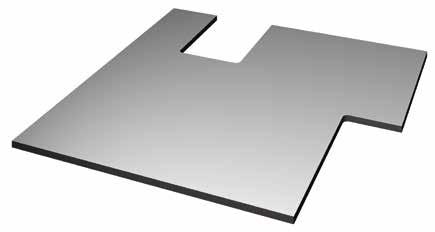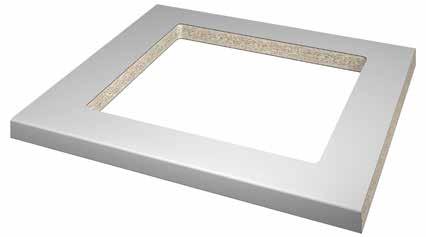
5 minute read
3. Processing
As described in chapter 2.2, ensure that the worktops are adequately conditioned before processing. The worktops must be conditioned for at least 24 hours under normal climatic conditions before processing.
3.1 Health risk due to dust formation
Dust may be generated during processing. There is a risk of sensitization of the skin and respiratory tract. Depending on the processing and the particle size, especially when inhaling dust, there may be further health risks. The formation of dust must be taken into account when assessing risks in the workplace. In particular in the case of machining processes (e.g. sawing, planing, milling), an effective extraction system must be used in accordance with the applicable health and safety regulations. If there is no adequate suction, suitable respiratory protection must be worn.
3.3 Cutting
The worktops can be cut to size using standard woodworking equipment, e.g. panel saws, bench circular saws, hand-held circular saws or jigsaws and also CNC routers. Panel saws or bench circular saws are generally used to cut the worktops to size. A good cutting result depends on different factors including whether the decor side is facing upwards, saw blade projection, feed rate, tooth shape, tooth spacing, motor speed and cutting speed.
Example Circular saw: → Cutting speed: approx. 40 to 60 m/sec. → Rotational speed: approx. 3,000 to 4,000 rpm. → Feed rate: approx. 10 to 20 m/min (manual feed) With the exception of panel saws and CNC routers, all cutting involves manual feed. Due to the high-quality melamine resins used for the surface of the EGGER laminate, the tool wear is considerably greater than with conventional woodbased materials. The Compact laminate worktop in particular leads to increased tool wear due to its high density. We recommend that you use carbide metal-tipped or even diamond-tipped saws cutters or router bits.
Use the following tooth shapes depending on the standard of finish you require (coarse or fine cut) – see figure 2 .
2
3.2 Fire and explosion hazard
Dust generated during processing can lead to fire and explosion hazards. Safety and fire protection regulations must be observed.
Flat tooth Duplovit tooth with hollow tooth face Pointed duplovit tooth
Use a cutting guide when working with a hand-held circular saw or jigsaw. Cutting must be from the underside of the board.
Saw type Decor side Application
Panel or bench circular saws
The worktop lies on the guide carriage and is guided towards the bench circular saw.
above
Front edge 1 towards the guide rail.
Feed direction 1
Hand-held circular saws or jigsaws
The hand-held circular saw is guided against the worktop.

Front edge 1 towards the operator.
underside
Feed direction
1
3.4 Edges and edging
The exposed edges of the EGGER worktop can be edged with thermoplastic EGGER ABS edge banding or EGGER melamine edging tape. For the manual application of melamine edging, normally PVAc glues or contact adhesives are used. The PVAc glue is evenly applied to the clean and dust-free chipboard edge using a paint brush. Then the melamine edging is pressed on with an edge press, glue press clamp or screw clamp using a stiff block of wood for protection and ensuring that there is sufficient overhang of edging on both the face and the underside of the worktop. The setting time can be substantially decreased by using heating bars.
Please follow the instructions provided by the machine manufacturer and adhesive supplier.
Edge milling cutters, files, chisels or sharp block planes are used for the finishing of melamine edging. The cutting should always be with light pressure at an oblique angle against the edge (shear action). EGGER melamine and ABS edges are used for the protection and design of worktops. Exposure to moisture in unprotected areas of the edges and well as in the hob and sink cut outs will lead to swelling. This is also the case with worktops which have a P3 (V100) chipboard core, which is often misleadingly described as “moisture resistant”. For more detailed information please refer to the “EGGER Edging ABS” processing information.
The Compact laminate worktop, on the other hand, has a homogeneous, closed edge due to its construction. The edges are milled in the factory and have a surrounding chamfer at the top and bottom edges as well as at the corners. If the panel dimensions are changed, the edges should preferably be milled after cutting. For an even more brilliant appearance of the edge quality, it is recommended to treat the compact laminate edge with oil. The oil offers additional protection against impurities and unwanted oxidation effects and thus guarantees a permanently perfect appearance.
RECOMMENDED EDGE OILS
Adler Leinölfirnis 95901 Adler Legno-Öl 50880ff Hesse Proterra Natural-Solid-Oil GE 11254 Rubio Oil Plus Pure (farblos)
3.5 Cut-outs
Before processing, ensure that the worktop is supported securely so that the sawing, routing or drilling work is not likely to cause any damage. In particular, narrow board areas surrounding apertures can break or crack if the board is inappropriately handled during processing. The board cut-outs should also be secured so that they cannot break or fall out in an uncontrolled way and thereby cause injury to individuals or damage property.
Oven and sink cut-out edges should be radiused (minimum radius > 5 mm) as sharp edges have an adverse effect on the material and can lead to crack formation – see figures 3 and 4 . This applies particularly to the hob area where the frequent exposure to heat causes the laminate to dry out, thereby increasing shrinkage tension.
Please specifically observe the instructions and installation templates supplied by the respective manufacturer!
3
Correct

4
Correct The cut-outs should preferably be made using a portable hand router or CNC milling machine. When using jigsaws, the cut-out corners should be pre-drilled with an appropriate radius and the cut-out sawn out from radius to radius. You should cut from the underside of the board to prevent the laminate coating from ripping off. The edges should be finished by means of sandpaper, filing or manual top milling to eliminate cracks due to chipping.

Due to the high cutting pressure, a safe workpiece and tool control is particularly important. Drill bits for plastic are best suited for drilling Compact laminate worktops. All edges should be smooth, free of cracks and notches – see figure 3 . Grooves and folds must also be chamfered to prevent notches. For installed components, sufficient space must be provided for expansion.
For more detailed information and corresponding tool recommendations for the Compact laminate worktop, please refer to the “EGGER Compact Worktop” Processing Instructions.

Incorrect

Incorrect





